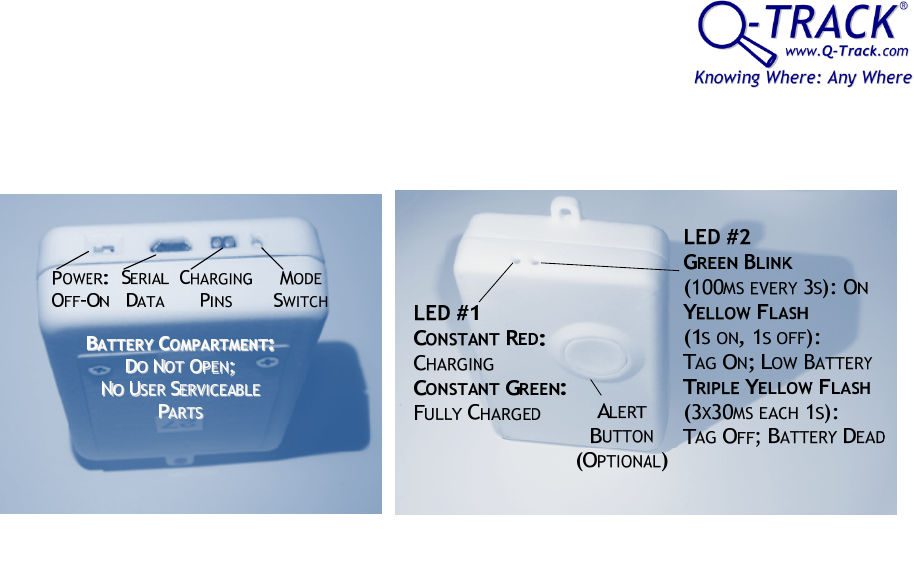The Q Track QT-600-TAG Tag Transmitter User Manual
The Q-Track Corporation Tag Transmitter Users Manual
Users Manual

Q-TRACK® QT™-600 TAG TRANSMITTER
QUICK START GUIDE
NOTE: CHARGE BEFORE FIRST USE!
The QT™-600 Tag Transmitter has a minimum of controls and interfaces:
Power Switch: For normal operation, turn the tag “o n” by moving this switch toward the
center of the case. Turn the tag “off” to co nserve battery or for long term storage by
sliding this switch toward the outside of the case.
Serial Data Port: This is not a USB port. The serial data port enables factory
configuration. The serial data p ort may also be used in conjunction with the supplied
charger (5V 500mA).
Charging Pins: These pins work in conjunction with the QT™-600 charging cradle.
Mode Switch: This momentary contact switch is for factory use only.
Alert Button (optional): Some versions of the QT™-600 tag include an Alert Button.
Pressing the Alert Button modulates the tag to notify the server of an alert situation.
The QT™-600 Tag Transmitter includes two dual color LEDs to communicate tag status:
LED #1
Constant Red: Charging
Constant Green: Fully Charged
LED #2
Green Blink (100ms every 3s): On
Yellow Flash (1s on, 1s off): Tag On; Low Battery Warning
Triple Yellow Flash (3x30ms each 1s): Tag Off; Battery Dead
The QT™-600 tag transmitter operates within the AM broadcast band (600–1600 kHz). The
specific transmit frequency is carefully chosen for each installation to avoid harmful
interference with licen sed emitters. AM broadcast signals would inte rfere with tracking and
must be avoided. The transmit frequency is set at the factory and cannot be changed by the
user. The QT™-600 tag transmitter is microprocessor-controlled and powered by a
rechargeable lithiumiion battery. The tag cannot transmit while being recharged. The
antennas are self-contained within the plastic enclosure, and cannot be modified or changed
by the user.
Q-Track Corp. FCC ID: VJ3-QT-600. This device complies with Part 15 of the FCC Rules. Operation is subject to
the following two conditions: (1) this device may not cause harmful interference, and (2) the device must accept
any interference received, including interference that may cause undesired operation.
Changes or modifications not express approved by the party responsbile for the compliance might void the user's
authority to operate the equipment.